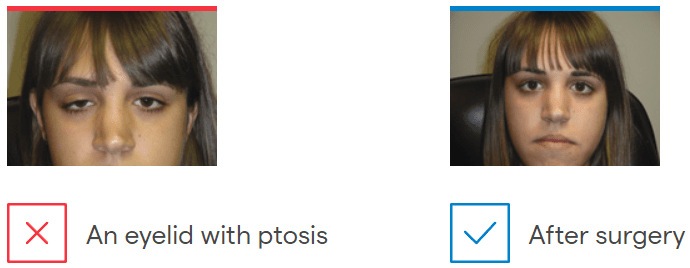What is ptosis?

Eyelid ptosis is the drooping of the upper eyelid. It usually occurs because of dysfunction of the levator muscle, due to degenerative or congenital causes.
What causes it?
Aging is the main cause of ptosis. There are different types of ptosis:
- Aponeurotic ptosis: this is the most common. It is caused by aging of the eyelid muscles and loosening of the levator muscle, causing the eyelid to droop.
- Neurogenic ptosis: an abnormality characterised by a lack of nerve stimulation in the muscle. It usually appears in children (Marcus Gunn syndrome).
- Mechanical ptosis: this occurs when there is a cyst or tumour in the upper eyelid causing “mechanical” drooping.
- Myogenic ptosis: the upper eyelid’s levator muscle does not work as it should, which means that the eyelid cannot remain in its normal position.
How can it be prevented?
Ptosis cannot be prevented, but it can be easily detected in its early stages. It is also possible to act before the visual field becomes affected and before the unsightly effect worsens. Correction prevents torticollis and neck pain, as well as discomfort associated with this dysfunction.
Symptoms
There are different symptoms associated with ptosis:
- The upper eyelid droops and partially or completely covers the eye
- The visual field is reduced
- The need to tilt your head back or lift your eyelid with your finger to be able to see
Associated treatments
The treatment for ptosis is surgery. The aim of surgery is to repair the tendon that lifts the eyelid or enable the muscle to recover its usual tone. At IMO, various techniques are used to correct ptosis, the choice of one procedure or another depends on the characteristics of each case. These procedures are performed without visible incisions and with minimally invasive techniques.
IMO Institute of Ocular Microsurgery
Josep María Lladó, 3
08035 Barcelona
Phone: (+34) 934 000 700
E-mail: international@imo.es
See map on Google Maps
By car
GPS navigator coordinates:
41º 24’ 38” N – 02º 07’ 29” E
Exit 7 of the Ronda de Dalt (mountain side). The clinic has a car park with more than 200 parking spaces.
By bus
Autobus H2: Rotonda de Bellesguard, parada 1540
Autobus 196: Josep Maria Lladó-Bellesguard, parada 3191
Autobuses H2, 123, 196: Ronda de Dalt – Bellesguard, parada 0071
How to arrive at IMO from:
IMO Madrid
C/ Valle de Pinares Llanos, 3
28035 Madrid
Phone: (+34) 910 783 783
See map in Google Maps
Public transport
Metro Lacoma (líne 7)
Autobuses:
- Lines 49 & 64, stop “Senda del Infante”
- Line N21, stop “Metro Lacoma”
Timetables
Patient care:
Monday to Friday, 8 a.m. to 8 p.m.
IMO Andorra
Av. de les Nacions Unides, 17
AD700 Escaldes-Engordany, Andorra
Phone: (+376) 688 55 44
See map in Google Maps
IMO Manresa
C/ Carrasco i Formiguera, 33 (Baixos)
08242 – Manresa
Tel: (+34) 938 749 160
See map in Google Maps
Public transport
FGC. Line R5 & R50 direction Manresa. Station/Stop: Baixador de Manresa
Timetables
Monday to Friday, 08:30 A.M – 13:30 PM / 15:00 PM – 20:00 PM





